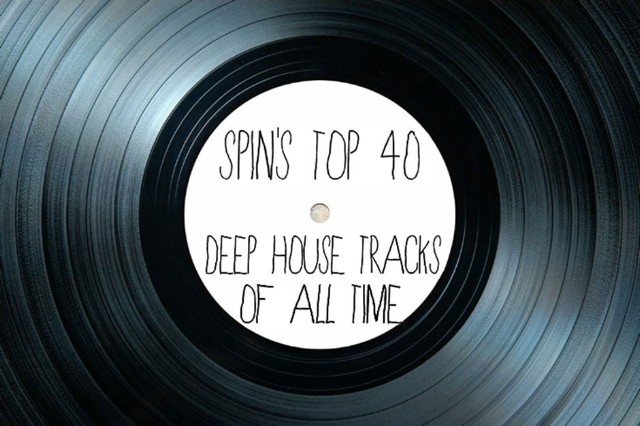Chez Damier, “Untitled” (KMS, 1993)
Three tracks, all untitled, all iconic enough that any house head will know what you mean if you say, “KMS 49, the B1.” Take your pick, really, depending on the time of night. The A-side cut comes together like a Lego project, with a scratchy boom-tick beat providing the foundation for a towering assemblage of tone clusters — piano chords, organ stabs, and monosyllabic vocal samples — that quiver brightly, faintly out of key with each other. Both tracks on the B-side are variations on the same set of sounds: a rippling, clap-heavy drum groove dusted with ride cymbals; endlessly spiraling Philly disco strings; and a bumptious funk bass line and squelchy wash of chords, which provided the blueprint for Daft Punk’s whole filter-disco shtick.The B1 opens with a deceptive snatch of falsetto a cappella and 16 bars of nothing but chords and cymbals, and then, boom: The kick-drum drops, the bass and strings kick in, and the whole thing basically hits a glorious plateau that lasts for six spine-tingling minutes. The only shift in energy is when someone breaks in to admonish, “You ain’t dancin’! Oh my god, you ain’t movin’, you ain’t dancin’, girl — you ain’t dancin’! C’mon!” The voice, a woman’s, is run through a pitch-shift effect that creates a gnarly echo in the low end, an effect both druggy and comic — but not, perhaps, as comic as the idea that this record has ever seen so much as a square foot of empty dance floor in 30 years of play. P.S.
Cajmere feat. Dajae, “Brighter Days” (Cajual, 1992)

Also Read
The 30 Best Britney Spears Songs
On paper, Curtis Jones’ split musical identity reads as a classic Dr. Jeckyll/Mr. Hyde scenario. He reserves his Cajmere alias for house productions, while the green-mohawked, dress-wearing Green Velvet dishes out white-knuckled techno with a cutting sense of humor. In reality, though, the line between the two is porous; one of Cajmere’s most famous tracks, “Percolator,” is as punishing and twisted as the gnarliest of Green Velvet’s output, and the low-slung purple funk of Green Velvet’s recent “Bigger Than Prince” could easily have been released as a Cajmere production. But he’s never gone deeper than on 1992’s “Brighter Days,” featuring the Chicago singer Dajae’s gospel-inspired R&B over shuffling drum programming and uplifting organ chords.Of the song’s many mixes, Louie Vega’s Masters at Work remix took it furthest, adding piano, looping and layering Dajae’s voice, and stretching the whole thing out to nearly 11 delirious minutes. Made in Chicago and given a soulful New York garage twist, it also anticipates the skipping rhythms that U.K. garage would adopt later in the decade. Closer to home, the song also had an impact on plenty of kids who would grow up to become footwork DJs and dancers, as evidenced by DJ Rashad and DJ Spinn’s recent track “Brighter Dayz.” Cajmere and Dajae’s song was a “classic hit for me and these guys,” Rashad told SPIN earlier this year. “Everybody out here, really. I might have been in seventh grade when that came out. It was just a song that we always like. It was like, man, we had to do it. We just did it our own way.” P.S.
Black Science Orchestra, “New Jersey Deep” (FFRR, 1994)
That this 1994 cut by Ashley Beedle, Marc Woolford, and Uschi Classen doesn’t necessarily scan as archetypical deep house says less about the song itself than about the genre’s gradual standardization over the years — its reduction, at least in certain circles, to two chords and a handclap. “New Jersey Deep,” on the other hand, has a ginormous breakbeat and great buttery streaks of Philly strings. It’s also got a rambunctious walking bass line. Hell, it’s even got a screaming electric guitar lead, which tears through the song like an unruly gust of wind, whipping the energy ever upward.The sample on which the song is based comes from Wood, Brass & Steel’s “Funkanova” — which, incidentally, Ron Trent lists as one of his 10 favorite deep-house tracks, despite the fact that it’s a jazz-funk song from 1976. (“One of Ron Hardy’s favorites,” he told Dummy. “Though this was released in the ’70s, it was fresh to the ears of the Chicago urban youth that it was being introduced to. When classics like this were being reintroduced to us, it was a mind opener. It was the introduction of what people like to now call ‘deep house.'”) It’s hard to believe that the whole thing clocks in at just four-and-a-half minutes; a masterful play of tension and release, tension and release, and tension and release, it feels like it goes on forever — in the best way. In a more perfect universe, it probably does. P.S.
Frankie Knuckles Presents, “Your Love” (Trax, 1987)
A superior and far more emphatic re-recording of Jamie Principle’s version released on Persona the previous year, this Chicago house classic borrows its bass line from Electra’s “Feels Good (Carrots & Beets),” a veggie-promoting Italian disco jam disproportionately big in the Windy City. It also has an uncredited Principle (a.k.a. Bryon Walton) crooning much like he did on the original, but here Frankie Knuckles — former DJ at the Warehouse, the Chicago club that gave house music its name — pumps the bass past the point of distortion, and the sequencer arpeggio that rips through the track similarly feels out of control. “I can’t let go. Ohhhhhhhhhhhh!” Principle sighs, implying the very opposite. Years later, an instrumental “Your Love” chunk would be mixed with a similarly vintage a cappella of Candi Staton singing “You Got the Love” for a U.K. Top 10 mashup. B.W.
Mr. Fingers, “Can You Feel It?” (Trax, 1986)
https://youtube.com/watch?v=UeiH9Mm0E5Y
Originally released as the middle cut of a three-track instrumental EP, “Can You Feel It?” would eventually eclipse in popularity and influence just about everything released under the many pseudonyms from Larry Heard, the most sophisticated composer amid Chicago’s original pioneers. Minimal like so much early house music but with a particularly subtle bittersweet dissonance, this is jazz rendered with house instrumentation — a particularly boing-ing bassline, hissy drum-machine hi-hats, similarly mechanical handclaps, and a low-key melody line that suggests a keyboard weeping in slow motion. Simultaneously severe and gentle, the soulfulness this track exudes would eventually inspire DJs and remixers to overlay various preachers on top — particularly Martin Luther King Jr. and his “I Have a Dream” speech — but its musical feng shu is best heard unadorned. B.W.




